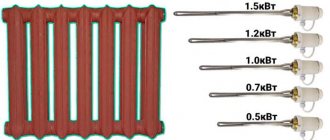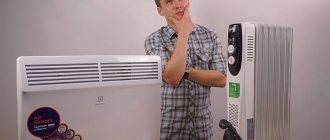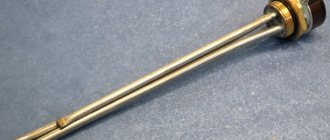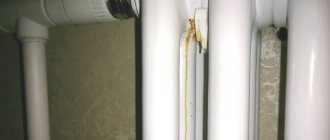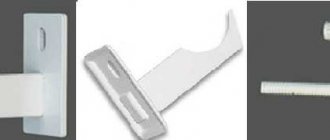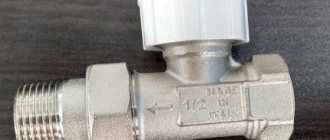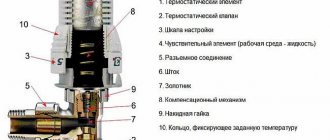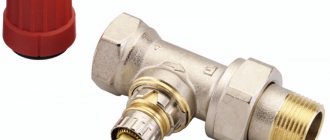The purpose of installing heating devices is to heat the room. Stores offer batteries, convectors, fan heaters and much more. Of course, every manufacturer praises its equipment and claims that its products are the highest quality. Let's do a little research and find out which is better - a convector or a radiator.
Pros and cons of radiators
The main function of a radiator is to heat the room. Not only the comfort in your apartment, but above all your health and, naturally, your budget depends on how well he copes with this. If the radiator does not heat well, you will spend money on additional heating methods and on medications. Therefore, this is an important thing during the heating season. Like any device, a radiator has its pros and cons.
Design differences
By design they are divided into 3 types:
- Panel
- Sectional
- Tubular.
Below we will consider these types and their pros and cons.
Panel devices consist of rectangular panels with vertical channels through which some kind of coolant flows (in most cases it is water). It has a beautiful appearance and is suitable for any interior. But there is a significant disadvantage - they create low working pressure. Therefore, in order for the coolant to circulate, additional pumps are needed. And this increases the cost of heating. Therefore, they are practically not used in the private sector.
Tubular radiators consist of bent steel pipes connected at the top and bottom by manifolds. This is the most expensive type of battery to operate.
The material used for sectional devices is cast iron, aluminum or steel. The radiator itself is assembled from sections, the number of which depends on the size of the room, its purpose (residential, office, warehouse), the need for heating intensity, etc. The most striking example of sectional radiators is the classic cast-iron radiators, which are familiar to any Soviet resident.
Differences between radiators by material of manufacture
Cast iron. This type of battery is still widespread, especially in apartment buildings built during the Soviet period. They are still produced today, albeit with an improved design.
Pros:
- suitable for any coolant;
- not capricious about the composition of the water, maybe dirty, hard, with fuel oil, with other impurities;
- if you use hard water in batteries, then, despite the contamination received over the years of operation, their heat transfer does not change;
- have the ability to retain heat for a long time;
- have a long service life, more than 40 years;
- able to withstand temperatures up to 1300C;
- if necessary, the number of sections can be changed, either reduced or increased, without any problems.
Minuses:
- have significant weight (one section 5-7 kg);
- it takes a lot of time to heat up the sections;
- have a small heat transfer area;
- unattractive design for today;
- They are difficult to clean, it is difficult to remove dust, dirt, etc. from them.
Aluminum. There are two types: European (standard) and reinforced. They differ in operating pressure, 6 and 12 atmospheres, respectively.
Pros:
- have high heat transfer;
- able to withstand high pressure levels;
- to increase the heat transfer area, additional plates are mounted to the main part of the radiator;
- compared to cast iron, they are light in weight and aesthetically pleasing;
- easy to install.
Minuses:
- the acidity of the coolant should not be high (Ph < 7.5);
- when used with other materials, for example, when attached to a riser made of another material, they are subject to corrosion;
- An automatic air vent is required, otherwise the sections will begin to collapse.
Steel. Most often used in the private sector, in individually built houses. They consist of radiators with plates that create channels for coolant circulation.
Pros:
- are light in weight;
- have good heat dissipation;
- heat up in a short time;
- easy to install;
- inexpensive.
Minuses:
- not designed for high pressure (therefore not suitable for multi-storey buildings);
- not resistant to corrosion;
- a constant presence of water is required.
Bimetallic. The design is based on an aluminum body with a steel pipe. The advantage of this type of radiator is that water does not come into contact with aluminum, as in aluminum radiators, but circulates through a steel pipe and transfers heat from it to aluminum panels.
Pros:
- Able to withstand high pressures - 20-30 atmospheres;
- The acidity of the coolant is not important;
- They have high heat transfer;
- They have a modern design and are able to heat large areas;
Minuses:
- the most expensive of all types of batteries;
- installation requires a specialist; if installed incorrectly, they can overheat and be destroyed;
- An automatic air outlet is required.
Tubular radiators made of steel. The design is based on 2 collectors connected by spot welding with steel tubes. A small volume of coolant is required for heating. They are located both vertically and horizontally, thereby suiting any design of any interior.
Pros:
- able to quickly change heating temperatures;
- They do not have a single standard and are distinguished by a wide variety of shapes and sizes.
Minuses:
- subject to corrosion;
- are expensive.
Having considered the pros and cons of radiators, we begin to choose the most suitable one.
Important! When choosing a device, you should pay attention to several things, not only its cost and aesthetic qualities, but also its reliability and durability in operation. We remember that the main function of a radiator is to make our home warm. Everything else, aesthetics, material, price, is secondary.
Before choosing, you must decide what area needs to be heated and what the average temperature should be there. We also pay attention to the quality of the water; if the acidity index of your water exceeds 7.5, then you should not buy aluminum batteries. If you have a small home, one type of radiator will do, if you have a large home, another type will do. Therefore, we begin any choice with the question: “For what purposes is it needed?” Heat 20 squares or 150. Depending on this, we will choose the best option. Our main goal when choosing is to save money.
Important! There is no point in buying a radiator designed for 100 meters for a room of 30 square meters and vice versa.
Differences between convectors and radiators
| Characteristics | Convector | Radiator |
| Heating principle | Heats only the air without heating surrounding objects: the floor, walls and furniture remain cold to the touch | Emits heat into the air and heats objects around it |
| Room heating speed | Fast - warms up the room 30 minutes after the coolant is supplied. Cools down at a similar rapid rate | Slow, but uniform and “long-lasting” - when the heating is turned off, it remains warm for at least 2-3 hours and continues to warm the room |
| Warm-up area | Small: they cannot cope with heating rooms over 20 square meters. m and rooms with ceilings higher than 2.5 m | Warm up any area, depending on the number and power of radiators |
| Design | Wall and floor models, suitable for installation in front of panoramic windows. Lightweight and compact | Wall-mounted and less commonly floor-mounted models. Bulky and heavy when it comes to cast iron radiators |
| Safety | The risk of burns is minimal. The risk of injury when hitting sharp “edges” is minimal | If the coolant temperature rises sharply, you risk burning your hand when touching the radiator. Hitting the radiator can cause serious injury. |
| Heat source | Central heating pipes or electricity | Central heating pipes |
| Heating element surface temperature | Heating plates - up to 100 degrees. They are covered with a protective casing that does not heat up above 50 degrees. Not suitable for drying wet mittens, warming hands and pets | The sections heat up to 90 degrees, depending on the temperature of the coolant. Be aware of the risk of burns. Dries wet mittens with a bang and warms hands, feet and chilled cats |
| Possibility of wet cleaning from dust | Requires painstaking cleaning with preliminary disassembly of the structure | Relatively easy to clean with a damp cloth |
| Air circulation | Intense and tangible, to the maximum in models with a fan for forced air circulation | Only natural air circulation. Drafts are minimal |
| Installation for allergic diseases and bronchial asthma | Not recommended because intense air convection occurs along with particles of dust, pollen, wool and other allergens | Optimal |
| Price | The price range is greater:
| The price range is smaller if we are not talking about antique models:
|
| Life time | Standard up to 10 years, with copper heating plates in the convector - up to 20 years | Long lasting: cast iron and copper work for 30 years or more, bimetallic up to 25 years |
| Noise effects | Clicking noises are heard when the heating plates heat up and cool down. If the power is selected incorrectly, the volume of clicks increases. In convectors with a fan, there is additional noise in constant mode. Noise is inevitable when pressure drops in the heating system or water with coarse impurities enters | Only in case of pressure drops in the heating system, the flow of water with impurities |
| Compatible with smart home systems | Electric models are combined with climate control systems with the option of controlling all convectors simultaneously. Convectors for central heating are combined when installing temperature sensors and regulators | Combined with a “smart home” using special thermostats. |
Table “Comparison of convectors and radiators”
What is better for heating – a convector or a radiator?
The purpose of installing heating devices is to heat the room. Stores offer batteries, convectors, fan heaters and much more. Of course, every manufacturer praises its equipment and claims that its products are the highest quality. Let's do a little research and find out which is better - a convector or a radiator.
Steel heating radiators
This type of product in question is less popular than aluminum radiators, but experts believe that this is incorrect. There are a lot of advantages that elevate steel heating radiators to the highest levels of the rating.
Advantages of steel heating radiators:
- It is possible to purchase tubular steel radiators or panel radiators. The latter option is very budget-friendly, it is often used in the installation of heating systems in private homes and is popularly called convectors. But tubular steel radiators will be much more expensive - this is due to the original production technology of the product in question.
- Both types of steel heating radiators have a high level of heat transfer - experts classify this indicator as excellent. At the same time, extremely low inertia is noted.
- Such products are absolutely harmless and environmentally friendly - they are used to equip heating systems literally everywhere: schools, kindergartens, hospitals, and so on.
- The volume of coolant required for the normal functioning of a system of steel heating radiators is extremely small.
- The cost of the product in question is low; such heating radiators are available to absolutely everyone.
Disadvantages of steel heating radiators:
- It often becomes necessary to drain the water from the entire heating system - in this case, the walls of the radiators come into contact with oxygen, and this provokes the development of corrosive processes.
- It is strictly forbidden to use steel radiators for arranging a heating system in multi-storey buildings - they are susceptible to water hammer like no other.
- Since the type of product in question has good convection, this can provoke the appearance of drafts and the rise of dust particles into the air.
Selecting a heating radiator
Using a radiator to heat a room is a heating method that has been used quite often and for a long time.
A radiator is a heating system device that heats a room through thermal radiation.
However, for its effective operation, it is necessary to take into account the nuances of operating various types of radiators, as well as know the functions and principles of operation.
Water radiator.
These are radiators in which circulating water is used as a coolant, which is supplied to the device using pipes. Such devices are used for constant heating in centralized and autonomous heating systems.
Water radiator
Advantages of a water radiator:
- They have high heat transfer and reliability.
- Heats a large area.
- If water radiators are connected to a single heating system, then the temperature in all rooms of the house will be uniform. At the same time, it is possible to install thermostatic valves and adjust the temperature in each room.
- They do not consume electricity.
However, this type of heating has a number of disadvantages:
- Complex installation required.
- Not mobile after installation.
- They are larger in size than, for example, a convector.
This type of heater is often used, however, it has less functionality and is not as convenient as more modern types of heaters.
Oil radiator.
This device is similar to the previous one in principle of operation, however, the coolant here is mineral oil instead of water. There is a heating element inside that warms up the oil, and it, in turn, gives off heat to the space around it. Such devices work by radiating heat and heating the air. This type of heater is usually not used as the main heating, but is chosen as an additional one.
Oil radiator
Pros of choosing an oil cooler:
- Can heat a large area.
- They work silently.
- There are built-in thermoregulation systems.
- Can be moved (unlike water systems).
- There is no need for complex installation.
The disadvantages of oil radiators are:
- Slow heating process.
- The radiator housing becomes very hot, which is why you can get burned on it. For this reason, it is not recommended for use where children may play.
- Mineral oil wears out over time, putting the device at risk of failure.
- This heater should not be left unattended - it is not intended for continuous operation.
- Large dimensions and weight complicate the process of transporting and moving the device.
- Powerful models have a fairly high price.
Thus, an oil heater is more efficient than a water heater, but has a number of disadvantages that must be taken into account.
What is the difference between heating batteries and convectors?
Purpose and principle of operation of built-in convectors
In-floor convectors, as their name suggests, are installed in the floor, flush with the floor covering. This design does not take up any useful space in the room, does not interfere with the arrangement of furniture and does not block the windows.
The built-in heater was specially designed to protect “French” (panoramic) windows and doors from condensation (moisture formation on the inside of the glass unit, or in other words, window fogging), which is formed due to the temperature difference between the outside and inside the room.
Moreover, such heating devices allow you to protect the room from the cold background from the windows. After all, no matter how expensive and energy-efficient double-glazed windows are, most of the thermal energy “flies out” through the window openings.
Features of the in-floor convector
Due to natural heat exchange, cold air enters the convector, where it passes through the hot heat exchanger of the device and thereby heats up. Heated air tends to rise, so it exits through the grille.
The smaller the depth and width of the convector, the less air volume passes through it, and, accordingly, the less power the device has.
Distinctive features of heating radiators
Radiators come with a convection zone, such as steel panel radiators, and without convection fins, like sectional radiators. The latter gives up to 80% of the heat to the room using radiation, and the remainder of the thermal energy is spent on heating the cold air circulating near the battery.
Heating radiators also differ in the material they are made of, which affects the quality of the heat transfer of the device. The construction of radiators is made primarily of steel, aluminum and cast iron, while the construction of convectors uses steel, aluminum and copper.
The design of the heating device does not allow it to be hidden in the floor, so it is necessary to allocate some space in the room for them. Most often, batteries are installed near windows or under window openings. The height of the lowest radiator in existence is 200 mm. However, it should be remembered that according to building regulations, the device must be installed with a minimum distance from the floor of 70 mm and a minimum of 50 mm must be provided from above.
The lowest option for a heating device, if you do not take into account in-floor convectors, are floor or wall convectors. Structures come in heights of 80 mm or more, but also require compliance with certain standards during installation: at least 80 mm from below the floor and 50 mm from above. Otherwise, such convectors lose their power and are practically useless. The advantage of such equipment is ease of installation, which does not require a complex fastening system.
Advantages and disadvantages of convectors
The answer to the question of which is better, a convector or a radiator, allows us to obtain an analysis of the advantages and disadvantages of both types of systems.
The advantages of the devices include:
- Autonomous operation mode.
- Low level of heating of the housing surface (up to +70 ᵒC).
- Quick heating of cold air (1-1.5 minutes).
- Lack of coolant and pipelines.
- Possibility of combining devices into one network.
- Convenient control of one or several devices simultaneously.
- Simplicity of design and installation of the installation.
- Quiet and environmentally friendly.
- Explosion and fire safety.
- Modern design.
The disadvantages are:
- Large amount of electricity used.
- High cost of multifunctional installations.
- Low level of electrical safety.
Who are convectors suitable for?
Most city residents will find convectors suitable and will be pleased with their design and rapid heating of indoor air. We deliberately exaggerated the example of Nikolai from the beginning of the article in terms of the number of circumstances. But the example shows that there are exceptions when convectors are undesirable.
A clear answer to the question “Convector or radiator?” Not sure it's going to happen. Take into account personal temperature and interior preferences, analyze whether it is important for you to sit on the floor and not freeze, whether you dry wet mittens, whether you want a panoramic window and whether you are ready to do wet cleaning more often.
We hope our table will help you compare the differences between convectors and radiators and make the right choice. An alternative is to buy a mobile electric convector for cold rooms, rather than making global changes to the house. Remember the goal: warmth in the house, not a heating device with bells and whistles.
Which heating devices are better?
- Technical characteristics of radiators
- Oil radiators for heating
- Technical features of convectors
- How are convectors used?
- Which is better to choose?
When it comes to heating a home, the first question that arises is which device to choose. According to the principle of operation, all heating devices are divided into two large categories: convectors and radiators.
According to the principle of operation, heating devices are divided into convectors and radiators. To choose the device that is suitable for you, you need to familiarize yourself with their characteristics.
Therefore, when it comes to the question of what is better to choose for heating a house, a radiator or a convector, the first thing you need to do is carefully study all the available advantages and disadvantages of such heating devices, and then make a decision. In order to install such devices, you must have the following tools:
The principle of operation of convectors is based on the fact that they heat a room through a flow of air, which heats up when it passes through the body of the heating device. Radiators heat the room by radiating heat from the surface body.
What distinguishes a convector from a radiator
The described devices are a type of heating devices. They can work independently or as elements of a heating system. The main difference between a convector and a radiator is the design and operating principle of the devices.
Radiator
It is a unit with a sectional metal body. All free space in the sections is filled with coolant. Water, special mineral oil or antifreeze liquid are used as a coolant.
The operating principle of the unit is based on the thermal radiation method. Under the influence of a heat source, the coolant is heated. This source is the heating element.
An increase in coolant temperature leads to heating of the surface of the device body. The heated body releases heat into the surrounding space. Under the influence of thermal radiation, the heating level in the room increases.
The coolant temperature is monitored by a built-in thermal sensor. Automation turns the device on and off when the set values are reached. The heating of the working fluid is controlled using a built-in thermostat.
Convector
To answer how a heating convector differs from a radiator, let’s consider the operating principle of the device.
The operation of the device is based on the convection of air masses in the room. It is an installation with a panel-type metal casing. The housing contains a heating element with a thermostat. The thermostat is used to regulate the heating temperature.
The housing has an open space at the bottom. Through it, a flow of cold air enters the housing. The heating element heats the cold air to a predetermined level. Heated air currents rush upward.
To accelerate and direct the warm air flow, special blinds are used in the device body.
Warm air masses displace cold air in the upper part of the room. The flow of cold air falls down. Below it again enters the device body. The working cycle of air movement is repeated.
The set temperature level in the room is controlled by a thermal sensor. Triggering of the sensor leads to automatic switching on and off of the device. Adjustment of the specified parameters is carried out using a mechanical or electronic control unit.
Advantages and disadvantages of convectors
Convectors are devices in which a heating element warms the warm air in the apartment by creating natural air circulation (convection), rather than radiation, like radiators.
Mainly consist of:
- made of a rectangular metal body;
- from an element that is responsible for heating and is mounted in the lower part of the device;
- thermostat.
The principle of operation of the convector is that unheated air, entering the lower part, passes through the heating device and, having heated up, leaves the device through the upper part. Due to the directed movement of warm air, the room heats up quickly and evenly.
There are:
- electrical;
- water;
- gas.
They are safe to use and do not require significant maintenance; just plug them in, set the required data and the device will start working.
Advantages of convectors:
- quickly heat the room; it has been established that the radiator heats the room twice as fast;
- equipped with a heat regulator; when the desired temperature level is reached, they turn off and turn on only when the temperature drops;
- fireproof, say, in contrast to an oil radiator, in which oil can catch fire;
- protected from overheating.
They also have a number of other advantages, such as compactness, ease of installation, compliance with modern design rules, etc.
They have disadvantages:
- consume a lot of electricity;
- can create drafts in the room;
- dry the air;
- accumulate dust.
When choosing a convector, you should take into account other factors, but first of all, your desires and financial capabilities.
How to choose a convector
Among Russian brands, convectors under the brands Ballu and Termica deserve attention. There are more European brands - they have accumulated more experience with convector heating; central heating is rare. The list of foreign convectors is led by Noirot, Thermor, Atlantic and Stiebel Eltron. The differences are minimal; it’s more a question of the availability of a particular brand in the right stores and personal love for brands. The noname convector options are also workable.
In an apartment with central heating, it is unlikely that the owners are planning a complete transition to electric convectors - electricity is more expensive than central heating. In addition, when convectors are constantly connected to the network, a noticeable load is created on the wiring - in the apartment and in the house. Residents of rare high-rise buildings can boast of new electrical wiring with a power reserve.
For example, let’s calculate the power of convectors that will be required to heat a three-room apartment. For every 10 sq. m of area accounts for a convector power of 1 kW. For an apartment of 80 sq. m - 8 kW. And this is in addition to other appliances that create peak load: kettle, electric stove, water heaters, oven, vacuum cleaner, etc.
For an electric convector, which is used as an addition to the central heating system, a power of 1-1.5 kW is enough.
Electric convector STIEBEL ELTRON CNS, power 1.5 kW - 8,600 rubles, Termokit.ru.
Convector with mechanical thermostat, power 1 kW - RUB 1,254, Leroy Merlin.
Device Operation
The difference in operation is also quite significant for devices such as a convector and a radiator. It will be useful to know the advantages and disadvantages before purchasing. In terms of energy costs, a convector is undoubtedly more profitable. It consumes 25% less energy than a radiator. This is due to the difference in the rate of heating of the air.
During operation, the convector also benefits in terms of mobility. It is lighter than the radiator, so moving the device will be easier. The ability to install the convector on the wall allows you to avoid cluttering the space. This factor simplifies cleaning in the apartment. An oil heater weighs from 18 to 25 kg, so moving it (especially when hot) is quite difficult. Even with wheels, this process is problematic.
How to get acquainted with convectors
The following happens more often. A conditional resident of a typical panel house - let's call him Nikolai - comes to visit an acquaintance - say, Rodion. Rodion lives in a similar “panel”. And then our Nikolai notices that the radiators under Rodion’s windows are different from the standard ones. More compact, without sections and protrusions - this appearance is much more pleasant. It turns out that these are not radiators at all, but convectors. Rodion’s apartment is warm, and there are convectors in all the rooms. Nikolai concludes that I need these too.
There is just one nuance: Rodion lives alone, works long hours, and the only other faces he sees in the house are the faces of old friends, seasoned in every sense, who come to play board games and drink “tea” every couple of months. Nikolai is just one of these friends. But at Nikolai’s house the situation is different: the ceilings are higher, up to 3 meters, two children and their friends are on the floor in all rooms at once, an allergic mother-in-law and his beloved wife, who always freezes at the slightest draft. At the same time, for the wife, as for Nikolai, the word “repair” is worse than multi-story curses. In such circumstances, replacing radiators with convectors is not recommended. The point is not the danger of family conflicts, but the objective differences between heating devices.
Heating the house with convectors.
So, heating the house with convectors. For many, this idea seems interesting, since it does not require such significant financial and time investments as, for example, heating with an electric boiler or using a heat pump. Any interest? Eat.
On the other hand, the idea of installing central heating at home using convectors can be immediately interrupted by such thoughts as:
- Will they even cope? Is there enough power? Convectors are to the south, where it is warm. In Moscow, the Urals and Siberia, it simply won’t work.
- It will create a load on the power grid - don’t worry, mom! There won't be enough electricity! The energy consumption will be scary to imagine!
- How to manage them? Approach everyone and set the desired temperature with your hands?
- And, in the end, all neighbors and friends have a boiler - electric or gas. The convectors will laugh...
Based on this, we see that there is a person who, as it were, is not against heating with convectors, but knows nothing about them and also has a false idea about them. And because of this, he is already beginning to lean towards boilers. At the same time, he also doesn’t understand anything about boilers, but everyone has them, so it’s right. But, as the classic bequeathed - “our people love everything ...” - let’s understand the problem.
Will the convector cope?
So, prejudice No. 1 - can a convector be considered a full-fledged heater suitable for use in heating a country house? Maybe.
Firstly, electric convectors have advanced quite a lot in technical terms. On our channel, the most common comment about convectors is “a piece of iron, with a spiral inside, burns oxygen, dries the air”! And such comments get a bunch of likes, and they are read by people who can remember it and accept it as it is. That is, the overwhelming majority are convinced that inside the convector there is a 50-year-old stich heating element and that this is the case in all convectors without exception - both for 2 thousand, and for 10, and for 20 thousand.
Modern monolithic X-shaped heating element - headgehog.
In reality - nothing of the kind. Good heaters have monolithic heating elements, which have a huge heat removal area, a relatively low temperature of the core itself, which does not become red-hot at all. So, not every convector can be used as a source of central heating, at least due to its manufacturability.
The next one is a convector, a heating source for rooms with good thermal insulation and a ceiling no higher than 3 - 3.2 meters. If you have adequate thermal insulation for your region, then a convector will be more than enough. If the ceilings are high, then you need something that will send hot air down from above. A ceiling fan can help with this. The solution is good, but expensive (something more or less decent starts from 40 thousand).
Answering the question posed, can a convector be considered an effective heating device in the central heating of a country house - it can! This is not just some local type of oil radiator, fan heater or quartz heater, it is a full-fledged powerful heating device.
Grid load and electricity consumption:
The next thing on the list of warning factors is the load on the power grid and electricity consumption. The thought that the convector will constantly turn off and turn on at its peak power is somehow not very good. And if there are, say, five such convectors and together they form the same 8-10 kW, it becomes even more unpleasant. Yes, this is a load on the power grid.
The classic scheme of on/off operation of the heater is operation in iterations and maximum load on the electrical network.
This shouldn’t worry us at all, since we will use convectors with inverter control and build an inverter heating system on them. That is, these are not just ordinary electric convectors. These are convectors, which are based on a completely different principle of controlling the heating element. Their peculiarity is that they can control the power of the heating element and smoothly reduce and increase it - from 0 to 100 in steps of 20%. That is, no peak loads, no surges. The same technology also affects the final consumption of electricity. On inverter technology in heaters and inverter heating systems, we will have a block of information below.
Neighborhood experience - boilers in action:
And my neighbor has an electric boiler, radiators and heated floors! Okay, let him stay with the neighbor. We will not allow such a mistake. Ask him how much money the boiler cost, the purchase of all the radiators, fittings, how much was spent on the work and at what stage it was all required. This is about the fact that this is never a finishing stage, but one when construction siphons a lot of money out of a person.
The boiler is no better: it is more expensive in terms of purchase, installation, electricity consumption, maintenance, it has a shorter warranty period, and if it fails, the entire heating system will collapse. There is not a single “for” in favor of the boiler when heating a house using convectors is opposed to heating with a boiler.
The exception is a gas boiler, but one-time investments in it on average start from 1 million rubles and the approval period is 6-8 months. For the same installation of a gas pipe, they will charge you the maximum; there is no fixed price. This is, conditionally, a monopoly and there will be no struggle for justice here.
Inverter convector control system:
So, we realized that heating a house with convectors is a very good idea and there is nothing to be afraid of. We also figured out that we are not talking about simple convectors, but about inverter ones, and it is rational to install the heating system on them and only on them. Now about this technology.
Inverter control of a convector is the principle of controlling a convector when it is possible to smoothly regulate the power of the heating element, based on data on changes in air temperature. Thus, the inverter-controlled convector operates smoothly, maintaining a balance in order to maintain the air temperature set by the person at the same level. The person set it to 24ºC - the convector holds it.
Inverter control of the convector - reach the desired temperature and reduce the power, remaining simply in the tº maintenance mode.
The inverter convector never turns off, it always works. It doesn’t even have, in the usual sense, a thermostat. When it is not heating, it goes to zero power, but does not turn off. Energy savings are achieved due to the absence of overheating of the room, because an increase in the difference between the internal and external temperatures increases the heat loss of the room, so it is important to maintain the air temperature at the same level. Only an inverter-controlled convector can keep the temperature smoothly, at the same level, since only they have the function of automatically adjusting the power of the heating element.
Toolkit – convectors in action:
We have a variety of heaters in our hands - from 1 kW to 2.5 kW in rated power. At the same time, the same 1 kW baby can work on its 200 watts.
In general, you can add other convectors to them - baseboard ones. The only point is that as of September 2022, only the 2 kW model comes with inverter control, the rest come with electronic control. Speaking about baseboard convectors, they are extremely narrowly targeted. What is their salt? They are long and low, so they can be placed along some panoramic windows. In some cases, they can be placed in the corridor. Their whole charm lies in the fact that they do not visually eat up space.
The choice of convectors for heating is large - from 0.5 kW to powerful 2.5 kW solutions.
Take, for example, a 0.5 kW baby - it is ideal for placing somewhere in the bathroom. It is very compact, is located somewhere in the legs and that’s it. You can also use a room thermostat as a tool by attaching one or several convectors to it.
For various areas, such as a vestibule or loggia, where thermal insulation is not very good, you can use infrared or infrared-convective heaters. This is not the main, but an auxiliary tool for rooms with insufficient thermal insulation or those areas where the use of convectors will not be effective.
Convectors can be placed either on the floor, placing them on wheels, or on the wall. In this case, it is important to foresee in advance which side of the convector the wire is on in order to route the socket correctly. It is also important to know that tulle, curtains, etc. should not hang over the convector; they should not be covered with anything.
The convector can be placed on a wheeled chassis or on the wall, mounted on brackets.
Safety:
Regarding fire safety, convectors must have a fire safety certificate. Since certification of heating equipment is voluntary, you need to check whether a particular model of electric heater has this certificate. The plastic must be non-flammable and the paint must not spark. That is, the convector should not become a source of fire - the plastic spreads into a puddle, but does not burn. The paint is peeling off, smoking, but not burning.
Regarding the protective sensors, ideally you need two of them: from overheating of the case and protection from falling. The second sensor has not been seen anywhere for a very long time, since its function is performed by the first - protection against overheating of the case, and in case of a fall, it will work quickly.
The following is the dust and moisture protection class. The second one is especially important – moisture protection. It is necessary so that the convector in heating a house can be used in showers, where there is high humidity and where water splashes may fall on the heater. All these requirements are met by the Rapid line of inverter convectors from Electrolux; these are the most reliable convectors in the Electrolux family.
Reliability and service:
From a technical point of view, a convector is a fairly simple unit: two sheets of metal forming a convection chamber, inside of which there is a heating element and a housing overheat protection sensor. If something fails, the entire element is replaced. The warranty on the heating module is 5 years.
A much more complex element is the inverter control unit. In practice, our online store never repaired them; the ASC always wrote them off. That is, they either work properly and wonderfully, or they stop working altogether; there are no intermediate values as such. The warranty on it is 3 years.
The convector itself does not require any preventive measures in relation to itself, it costs itself and that’s it. After a long period of inactivity, dust will accumulate on the heating element, which will burn when turned on for the first time, there will be a specific smell, but after 20-30 minutes everything will disappear.
If suddenly something happens to the heater, you do not lose the entire heating system: a specific link is lost, and everything else continues to work as it should. The issue of replacement is resolved very quickly and easily. That is, there will be no questions about opening niches, there is no need to unscrew the baseboard anywhere or remove the finishing coating in order to get to any pipe, shut off the system or anything else.
For example, we fully guide a person from the moment of heating calculations to the purchase and implementation of this system, throughout the entire warranty and post-warranty period. Over the 3 years that the inverter heating system has been in existence, there have been no more than five warranty cases on the most reliable Electrolux Rapid line within houses.
System management:
You can control each heater individually by directly approaching it and setting the necessary settings. You can control it using your smartphone by connecting each heater to Wi-Fi. You can even use room thermostats for them, which will measure the air temperature at the place where they are installed.
A demo of Wi-Fi control can be viewed here.
It is also possible to program convectors to operate by day of the week, both via Wi-Fi and manually. Potentially, there should be functionality for launching convectors according to their priority: this will be relevant for cases where there is a limit on electricity. In my opinion, this is an option because you have to understand that you generally do not have enough electricity...
You can manually and via Wi-Fi set the power of each heater - the same step of 20%. The next development of home heating with convectors will be to increase the number of power steps; there will no longer be five, but ten.
Results:
Heating a house with convectors is a successful and good solution. It's better than an electric boiler. At the wiring stage, you only need to take care of laying the wires to the right place and provide a separate machine for each convector. Despite the fact that the convector is an inverter, its peak power remains high. You can order a calculation of home heating with convectors from us.
Additional functions
Convectors:
- Electronic control, display, remote control. These “bells and whistles” allow you to more accurately set the required temperature and control the device without leaving the couch. Radiators with a mechanical thermostat cannot boast of such accuracy.
- Operating modes. Most convectors are equipped with preset modes that allow, for example, saving energy (“economy” mode).
Oil radiators:
- Drying things. Additional slats where you can hang and dry things are the strongest advantage of the radiator. This trick will not work with convectors.
General features:
- Built-in ionizer. There is still debate about the benefits of air ionization, however, many models have this option.
- Frost protection. A function that allows you to maintain a low positive temperature in the room for a long time if the owners are absent for a long time.
- Humidifier. A useful option especially for dry climates. Moreover, the humidifier works autonomously and can always be turned off if the room is very damp.
- Timer. Allows you to preset the time by which the device will warm up the room.
What is better to buy a convector or radiator for an apartment?
Having considered the pros and cons of radiators and convectors, let’s begin to compare them. It should be immediately noted that the development of technology is rapidly moving forward, most of the shortcomings are being eliminated, and today it is difficult to detect a significant difference between radiators and convectors. But let's try to find the main differences.
Compactness. Convectors win in this category. They are more compact than radiators and take up less space, especially when compared with older models.
Heating the room. Convectors cope with this task much faster. But at the end of the work, the convector immediately stops heating the room, while the radiator still gives off heat.
Safety. Since a convector heats its body to lower temperatures than a radiator, it is generally accepted that a convector is safer. You can get burned from an overheated radiator surface, but this is impossible from a convector.
Heating large rooms. Here, of course, the convector gives way to a radiator. Radiators are capable of heating large rooms. While a convector cannot do this.
In terms of ease of maintenance, radiators are simpler. All you have to do is wipe off the dust, rinse and that’s it. Convectors must be cleaned and disassembled. Since with air circulation a lot of dust with various small particles gets inside.
Price. At the moment it is difficult to find a definite answer. Recently, so many models have been invented and designed that deviations can be found in both one and the other direction.
These and other questions will guide your choice. Before doing this, it is also recommended to consult with a specialist.
How does a convector work?
The convector heats only the air - cold air from the window and from the ceiling passes through the heating plates of the convector, exits as a hot stream to the floor and rises again to the ceiling. In essence, this air circulation is called convection. There is convection when heating a room with a radiator, but to a lesser extent. The convector makes the air circulate more intensely and, as a result, warms up the room faster. At the same time, you won’t notice any noticeable heat, like from a radiator, from a convector - the walls and objects around remain at room temperature.
comparison table
Having considered all the pros and cons, and also analyzed the advantages and disadvantages of competitors, we can safely say that convectors are superior to obsolete oil radiators in almost all respects. If you decide to add warmth to your home, then they will be the best choice.
PS You can determine the required power of an electrical appliance to heat a room of a certain area using this guide.
Durability
The convector and radiator have different service life. The differences in this indicator are significant. Of course, a lot depends on the manufacturer and build quality of the device. Taking into account the general principle of operation of such equipment, experts advise purchasing convectors. Their service life reaches a record 15 years.
Oil radiators cannot boast of such indicators. The substance inside the sections corrodes their material. Therefore, such devices rarely operate for more than 7 years. And most models are not used even longer than five. First, a microcrack appears in the housing. It is not visible to the naked eye. Over time, it increases and oil begins to leak out. Such heaters cannot be repaired. Therefore, it is better to give preference to convector devices.
Which is better - a radiator or a convector?
The use of modern convectors for centralized heating meets basic consumer requirements. This is a modern type of heater that has many advantages. Convectors can be built into any partition or floor so that they are not visible. Such devices can easily replace conventional radiators, which do not always fit harmoniously into the interior.
Underfloor heating convector is a modern solution for home and apartment
However, in urban apartments with a standard layout, some models of convectors are simply impossible to use. For example, it will not be possible to install such a device inside the floor.
Otherwise, such models are a good solution for organizing home heating; you just need to give preference to high-quality devices and correctly calculate their power and quantity.
Features of installation of an in-floor convector
When the decision to install an underfloor convector instead of a heating radiator is finally made, it is necessary to select heating equipment of suitable power. For a private home, this is especially important because many such housing have a large area, which is quite problematic to heat. If the calculation of the required power of an in-floor convector for each room in the house is carried out independently, it should be remembered that the calculation is not very different from a similar procedure for traditional heating radiators. Therefore, you should not “reinvent the wheel”, but do the following.
- The area of the room in which it is planned to install the in-floor convector is determined by simply multiplying the length of the room by its width.
- The area of the room obtained by multiplication is then multiplied by 100 W, which ultimately gives the required power of the convector, expressed in watts.
Experts recommend not installing one heating device in a room, but using several in-floor convectors, for example, according to the number of window and door openings. In this simple way, you can achieve the most uniform heating of the air in the room, especially if the convector design does not include a fan.
Types of convectors for apartments
By type of heat source
- For central heating
, these are installed instead of radiators. - Electric
- to supplement central heating with an additional element. It is practical if you need to heat the apartment before starting heating or add heat in a corner room where the walls are frozen and there is not enough radiator power.
By design
- Wall-mounted
- installed similarly to radiators under windows. Electric wall convectors are also placed in other places where additional heat is required. The main thing is that there is an electrical outlet available.
Wall-mounted electric convector Thermor Evidence 2 Elec with electronic thermostat, 1 kW — RUB 3,639, Studiya-climata.ru.
- Floor and in-floor
- a godsend when installed in front of panoramic windows, sliding doors, in a spacious corridor to create a thermal curtain in front of the entrance to the living room. In-floor ones are more difficult to install and are installed during major renovations.
Trench convector with natural convection TECHNO, length 80 cm, power 157 W, for central heating - RUB 5,686, Termokit.ru.
Trench convector with forced convection “Breeze”, length 1 m, power 1,497 W, for central heating - 20,035 rubles, Termokit.ru.
Helios Floor floor convector, height 80 cm, length 1 m, power 491 W, electric - RUB 7,473, Helios-heating.ru.
- Skirting boards
are long and narrow, mounted at an angle in the place where the baseboard is placed by default. As a result, convectors do not stand out in the interior, look like ordinary baseboards and evenly heat the room.
Warm Helios baseboard for central heating - from RUB 3,800. per p.m., Helios-heating.ru.
- Mobile
- for rearranging to the desired room. Legs for the convector can be purchased separately.
Convector BALLU RED EVOLUTION with electronic thermostat, 1 kW - 5,516 rubles, Termokit.ru.
Legs for convector with wheels - 298 RUR, Leroy Merlin.
How to make the right choice
The numerous radiators and convectors currently on the market are varied, so choosing just one device will not be so easy. It must be remembered that each device, regardless of its type, has its own advantages, and in many situations they are able to operate at almost equal power. Keep in mind that any radiator of correctly selected power will warm the room, but a convector is much safer and does not cause any inconvenience - this is the main difference between the devices.
If we are talking about a small room, it is better to choose a radiator; this is the best option for heating a local space.
When it comes to what is better - a convector or a radiator, many mention the extremely low cost of the second option, which also significantly increases the demand for it. Despite this, innovative and modern convectors are becoming more and more popular every year, as manufacturers produce additional modifications of such devices. Now they can be installed in any room, built into the floor (in-floor models), mounted on the wall (wall-mounted) or placed on the floor (floor-mounted) in a convenient and most suitable place. To make the right choice, you need to take into account the features of a particular room, its area, decoration, size and design. You can choose either a radiator or an electric convector of any type.
( 2 ratings, average 5 out of 5 )
Water convectors
Equipment of this type does not depend on electricity; it operates using coolant, which is supplied through pipes from the heating system. In this case, the boiler is responsible for heating the coolant, which can be gas, electric, solid fuel or universal. The simple internal structure of water convectors quickly warms up the room and is easy to operate.
Water convectors are equipped with powerful heat exchangers, which are made of steel or non-ferrous metal. Copper and aluminum heat exchangers are quite expensive, but they are not subject to corrosion either inside or outside. Water flows through copper tubes with aluminum fins, thanks to which the air in the convector is heated.
Water convectors can be of different types:
- Wall-mounted devices are installed on the wall; the best option for their location is a place under the window.
- Floor convectors are located under panoramic windows or window openings, the window sills of which do not reach the floor.
- Built-in devices require hidden installation in wall niches. Such equipment is suitable for creating invisible heating systems.
- In-floor convector equipment is installed under panoramic windows to prevent condensation from forming on the windows.
Water convectors have many advantages, among which the following stand out:
- There is no need to connect to the power supply, the heating process occurs due to the hot coolant.
- A heating system with a water convector makes it possible to get greater benefits if you do not use an electric boiler.
- The device has a fairly simple and compact appearance.
- Heating using a water convector is highly efficient.
Of the disadvantages, the following are of particular importance:
- Insufficient efficiency when heating rooms with high ceilings.
- A more complex installation that requires piping throughout the house.
- Steel heat exchangers are susceptible to corrosion.
If we compare electric and water convectors, the second option is more economical if powered by an economical heat source. In terms of control, water boilers look simpler; a certain temperature is set on the heating system boiler. In addition, heating systems with a water convector, powered by an electric boiler, can be converted to a gas boiler.


